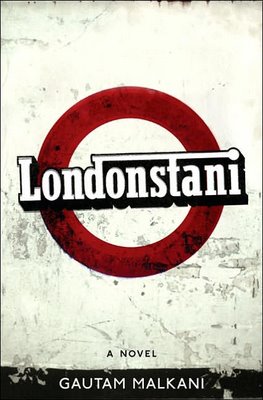 Just finished reading Londonstani by Gautam Malkani. It is a novel, giving fascinating glimpses into the NRI (non-resident Indian) community in London, UK. Although it is a novel, I hope to god the author is not too off the mark in his portrayal of the NRI community because we, the general readers, can't help thinking of novels such as these as the real windows into a community of people.
Just finished reading Londonstani by Gautam Malkani. It is a novel, giving fascinating glimpses into the NRI (non-resident Indian) community in London, UK. Although it is a novel, I hope to god the author is not too off the mark in his portrayal of the NRI community because we, the general readers, can't help thinking of novels such as these as the real windows into a community of people.I am more familiar with the NRI community in the US, particularly the young immigrants (not so affectionaly called FOBs, fresh off the boat), being one myself. So, I found it really interesting to read about the Indian community in the UK, the young kids and adult Indians who were born there, and their immigrant parents. The similarities and differences between the Indians in India, the UK and the US was indeed fascinating. I will not try to list here the similarities and differences I noticed, because that is not the point of this blog post. Moreover, your own list might vary significantly from mine. Nevertheless, I always like to read about contemporary Indians, wherever they are.
The main protagonist of Londonstani is Jas, who narrates the story in first person, using what is supposed to be London's desi slang, as his preferred language. The story is of Jas and his three friends, who are all somewhere close to 20 years of age. None of them are doing well in their studies, and just seem to be drifting along in life. They have a small cell-phone operation, which is not exactly legal. However, their small caper leads them into something unexpectedly big-time, before ending in a somewhat lame climax. En route, we get to witness immigrant life in London: the attitudes of the younger generation versus their parents, the relationship dynamics within families, the dynamics between the youth, influenced by their religion and gender, assimilation issues, identity and young manhood issues, etc. The story includes all the typical elements of an Indian movie: youthful mischief, budding romance, marriage, death, funeral, family fights, actual physical fights between guys and even a suave, intelligent villain who is as bad and manipulative as any movie villain. Despite all that, it is not really a typical Indian movie story.
I felt that the novel was a little slow in clearly establishing the identities and personalities of three of the four main characters. Hardjit, the Punjabi body-builder and wrestler, is the only character who gets assertively delineated early on. Even the main protagonist, Jas himself, takes some to come out of the fuzzy vision. May be that was deliberate and is in line with the personalities of the characters.
The writing is funny and witty, especially in its observation of the many unique characteristics and quirks of Indians, their attitudes, beliefs, their lives. However, there were many occasions when I was reading the book and I thought, "This is supposed to be funny, I should really be laughing hard at this, but why am I not?" I still don't know why I was not laughing hard, although I did chuckle and smile quite frequently. The description and explanations in the desi-ghetto slang, that too from a youthful perspective, was supposed to be half the fun. But may be it was this very slang which prevented me from fully empathizing with the narration and laughing hard, or may be it was something else. May be other readers might have indeed laughed harder. Nevertheless, I did get the feeling sometimes that the author was trying too hard to be funny or to make a point or to describe something.
In at least two chapters, the author uses a mixed-timeline narrative style. In the dance club chapter, the narration skips back and forth over events which take place on two consecutives evenings. Towards the end of that chapter, the back and forth switch between the two evenings is more rapid, until at the very end, they actually seem to blend together. (SPOILER WARNING: Rest of this paragraph!) In the funeral chapter, you think you are reading about events that took place at one point of time, but when you reach the end of the chapter, the author displays a sleight of hand, and you realize that you are actually reading about events which happened at least a couple of weeks later.
This unexpected sleight of hand by the author is again evident at the very end of the story, a surprising twist in almost the penultimate page. The climax is kind of lame, but the twist which follows, tilts the whole story a bit. I finished reading the novel late last night and the twist has still not fully sunk into my mind this afternoon. In many good novels which have a final twist in the tale, that last surprise causes the main piece or many pieces of the puzzle to fall in place, explains many things, and neatly ties up the story for us. The final twist in Londonstani is probably supposed to do that, but it has quite not done that for me. I don't know why that twist was necessary.
Despite the ending, Londonstani was an entertaining novel to read.









No comments:
Post a Comment
Please do not comment as Anonymous. Please use a name when commenting... even a false one will do! :-) You don't have to register to use a name.